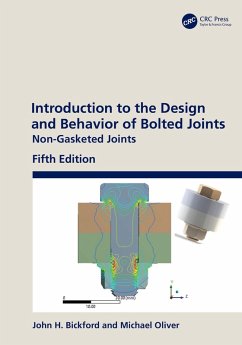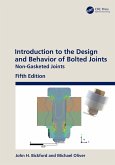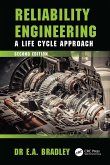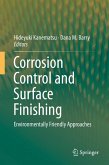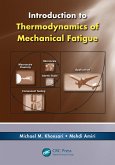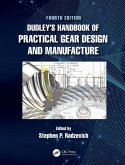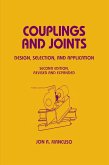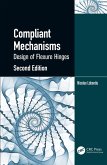John H. Bickford, Michael Oliver
Introduction to the Design and Behavior of Bolted Joints (eBook, PDF)
Non-Gasketed Joints
162,95 €
162,95 €
inkl. MwSt.
Sofort per Download lieferbar

81 °P sammeln
162,95 €
Als Download kaufen

162,95 €
inkl. MwSt.
Sofort per Download lieferbar

81 °P sammeln
Jetzt verschenken
Alle Infos zum eBook verschenken
162,95 €
inkl. MwSt.
Sofort per Download lieferbar
Alle Infos zum eBook verschenken

81 °P sammeln
John H. Bickford, Michael Oliver
Introduction to the Design and Behavior of Bolted Joints (eBook, PDF)
Non-Gasketed Joints
- Format: PDF
- Merkliste
- Auf die Merkliste
- Bewerten Bewerten
- Teilen
- Produkt teilen
- Produkterinnerung
- Produkterinnerung

Bitte loggen Sie sich zunächst in Ihr Kundenkonto ein oder registrieren Sie sich bei
bücher.de, um das eBook-Abo tolino select nutzen zu können.
Hier können Sie sich einloggen
Hier können Sie sich einloggen
Sie sind bereits eingeloggt. Klicken Sie auf 2. tolino select Abo, um fortzufahren.

Bitte loggen Sie sich zunächst in Ihr Kundenkonto ein oder registrieren Sie sich bei bücher.de, um das eBook-Abo tolino select nutzen zu können.
The fully updated 5th edition provides a practical, detailed guide for the design threaded bolted joints, the tightening of threaded joints, and the latest design procedures for long-term life. New sections on materials, and threads and their strength, have been added, and coverage of FEA for design analysis is now included.
- Geräte: PC
- ohne Kopierschutz
- eBook Hilfe
- Größe: 26.98MB
Andere Kunden interessierten sich auch für
![Introduction to the Design and Behavior of Bolted Joints (eBook, ePUB) Introduction to the Design and Behavior of Bolted Joints (eBook, ePUB)]() John H. BickfordIntroduction to the Design and Behavior of Bolted Joints (eBook, ePUB)162,95 €
John H. BickfordIntroduction to the Design and Behavior of Bolted Joints (eBook, ePUB)162,95 €![Reliability Engineering (eBook, PDF) Reliability Engineering (eBook, PDF)]() Edgar BradleyReliability Engineering (eBook, PDF)90,95 €
Edgar BradleyReliability Engineering (eBook, PDF)90,95 €![Corrosion Control and Surface Finishing (eBook, PDF) Corrosion Control and Surface Finishing (eBook, PDF)]() Corrosion Control and Surface Finishing (eBook, PDF)113,95 €
Corrosion Control and Surface Finishing (eBook, PDF)113,95 €![Introduction to Thermodynamics of Mechanical Fatigue (eBook, PDF) Introduction to Thermodynamics of Mechanical Fatigue (eBook, PDF)]() Michael M. KhonsariIntroduction to Thermodynamics of Mechanical Fatigue (eBook, PDF)81,95 €
Michael M. KhonsariIntroduction to Thermodynamics of Mechanical Fatigue (eBook, PDF)81,95 €![Dudley's Handbook of Practical Gear Design and Manufacture (eBook, PDF) Dudley's Handbook of Practical Gear Design and Manufacture (eBook, PDF)]() Dudley's Handbook of Practical Gear Design and Manufacture (eBook, PDF)180,95 €
Dudley's Handbook of Practical Gear Design and Manufacture (eBook, PDF)180,95 €![Couplings and Joints (eBook, PDF) Couplings and Joints (eBook, PDF)]() Jon R. MancusoCouplings and Joints (eBook, PDF)340,95 €
Jon R. MancusoCouplings and Joints (eBook, PDF)340,95 €![Compliant Mechanisms (eBook, PDF) Compliant Mechanisms (eBook, PDF)]() Nicolae LobontiuCompliant Mechanisms (eBook, PDF)57,95 €
Nicolae LobontiuCompliant Mechanisms (eBook, PDF)57,95 €-
-
-
The fully updated 5th edition provides a practical, detailed guide for the design threaded bolted joints, the tightening of threaded joints, and the latest design procedures for long-term life. New sections on materials, and threads and their strength, have been added, and coverage of FEA for design analysis is now included.
Dieser Download kann aus rechtlichen Gründen nur mit Rechnungsadresse in A, B, BG, CY, CZ, D, DK, EW, E, FIN, F, GR, HR, H, IRL, I, LT, L, LR, M, NL, PL, P, R, S, SLO, SK ausgeliefert werden.
Produktdetails
- Produktdetails
- Verlag: Taylor & Francis eBooks
- Seitenzahl: 614
- Erscheinungstermin: 30. Dezember 2022
- Englisch
- ISBN-13: 9780429520709
- Artikelnr.: 66778501
- Verlag: Taylor & Francis eBooks
- Seitenzahl: 614
- Erscheinungstermin: 30. Dezember 2022
- Englisch
- ISBN-13: 9780429520709
- Artikelnr.: 66778501
- Herstellerkennzeichnung Die Herstellerinformationen sind derzeit nicht verfügbar.
John H. Bickford worked as a Private Consultant, Middletown, Connecticut prior to his retirement. He also served as Vice-President and Manager of the Power-Dyne Division at Raymond Engineering, Inc. in Middletown, Connecticut. He is a member of the American Society of Mechanical Engineers, and Founder and former President of the Bolting Technology Council.
Michael Oliver earned his B.S. degree from North Carolina State University, and his M.S. and Ph.D. from the University of Dayton. His work with fastener technology began when he worked at Delphi Automotive in Dayton, Ohio, as their Senior Fastener Engineer, running their Fastener Test Lab for 10 years. During this time period Dr. Oliver received his Ph.D. in Threaded Fasteners. He spent the rest of his career dealing with sustainment issues of aerospace structures, which also included aerospace threaded fasteners. His lab performed thread inspections using System 23 thread gaging as well as TIR on various locations on threaded fasteners. We obtained thread and under-head coefficient of friction values, established torque/clamp-load correlations, and created residual torque values for quality audits. Testing was a big part of my job. The remining time was spent traveling the world dealing with is called quality spills (some company did something that usually changed either the frictional coefficient(s) or material properties of one of the members of the threaded bolted joint).
Michael Oliver earned his B.S. degree from North Carolina State University, and his M.S. and Ph.D. from the University of Dayton. His work with fastener technology began when he worked at Delphi Automotive in Dayton, Ohio, as their Senior Fastener Engineer, running their Fastener Test Lab for 10 years. During this time period Dr. Oliver received his Ph.D. in Threaded Fasteners. He spent the rest of his career dealing with sustainment issues of aerospace structures, which also included aerospace threaded fasteners. His lab performed thread inspections using System 23 thread gaging as well as TIR on various locations on threaded fasteners. We obtained thread and under-head coefficient of friction values, established torque/clamp-load correlations, and created residual torque values for quality audits. Testing was a big part of my job. The remining time was spent traveling the world dealing with is called quality spills (some company did something that usually changed either the frictional coefficient(s) or material properties of one of the members of the threaded bolted joint).
Basic Concepts. Materials. Stress and Strength Considerations. Threads and Their Strength. Stiffness and Strain Considerations. Introduction to Assembly. Torque Control of Preload. Torque and Turn Control. Other Ways to Control Preload. Theoretical Behavior of the Joint under Tensile Loads.Behavior of the Joint Load in Tension: A Closer Look. In-Service Behavior of a Shear Joint. Introduction to Joint Failure. Self-Loosening. Fatigue Failure. Corrosion. Selecting Preload for an Existing Joint. Design of Joints Loaded in Tension. Design of Joints Loaded in Shear. Appendix A: Units and Symbol Log. Appendix B: Glossary of Fastener and Bolted Joint Terms. Appendix C: Sources of Bolting Information and Standards. Appendix D: English and Metric Conversion Factors. Appendix E: Tensile Stress Areas for English and Metric Threads with Estimated ''Typical'' Preloads and Torques for As-Received Steel Fasteners. Appendix F: Basic Head, Thread, and Nut Lengths. Index.
Basic Concepts. Materials. Stress and Strength Considerations. Threads and Their Strength. Stiffness and Strain Considerations. Introduction to Assembly. Torque Control of Preload. Torque and Turn Control. Other Ways to Control Preload. Theoretical Behavior of the Joint under Tensile Loads.Behavior of the Joint Load in Tension: A Closer Look. In-Service Behavior of a Shear Joint. Introduction to Joint Failure. Self-Loosening. Fatigue Failure. Corrosion. Selecting Preload for an Existing Joint. Design of Joints Loaded in Tension. Design of Joints Loaded in Shear. Appendix A: Units and Symbol Log. Appendix B: Glossary of Fastener and Bolted Joint Terms. Appendix C: Sources of Bolting Information and Standards. Appendix D: English and Metric Conversion Factors. Appendix E: Tensile Stress Areas for English and Metric Threads with Estimated ''Typical'' Preloads and Torques for As-Received Steel Fasteners. Appendix F: Basic Head, Thread, and Nut Lengths. Index.
